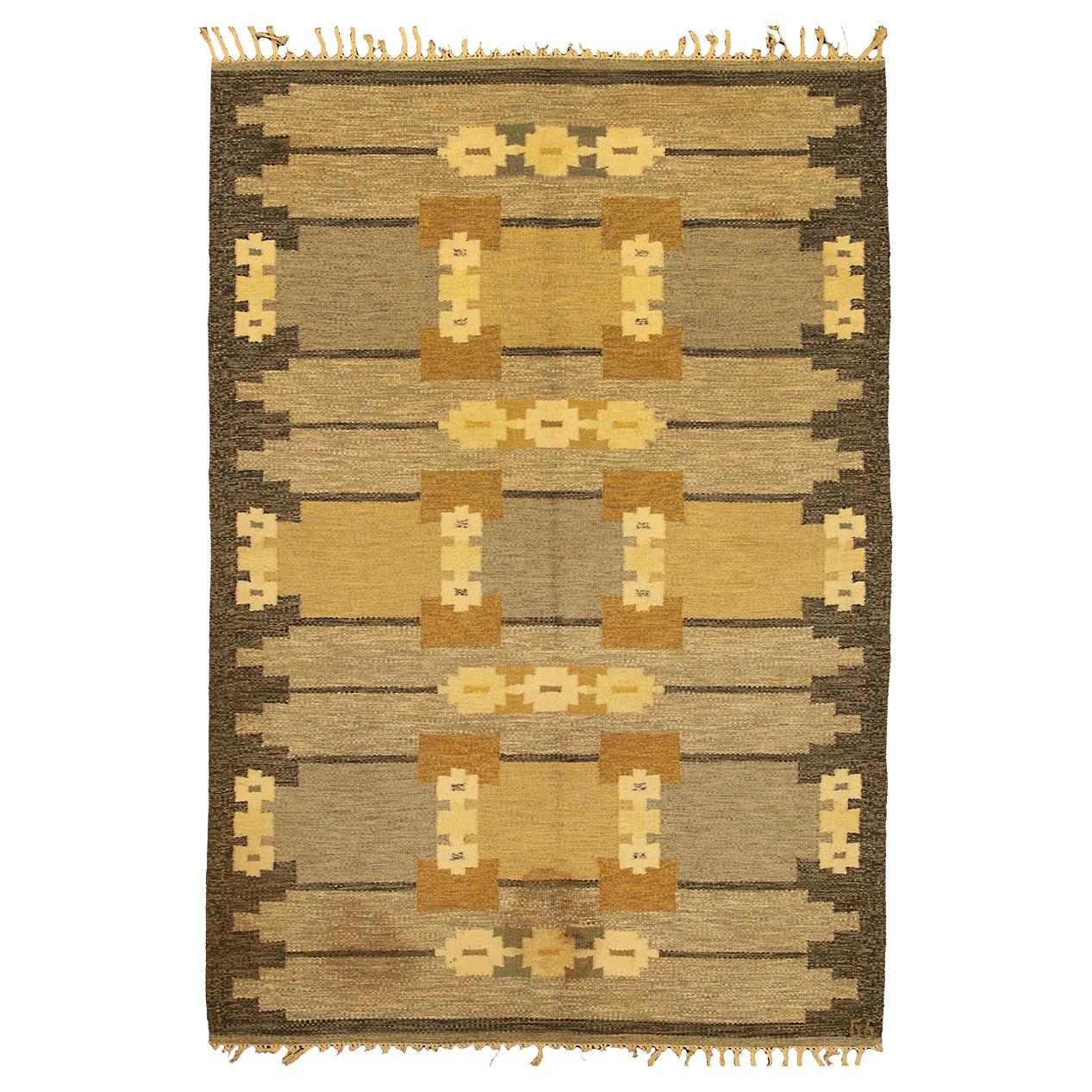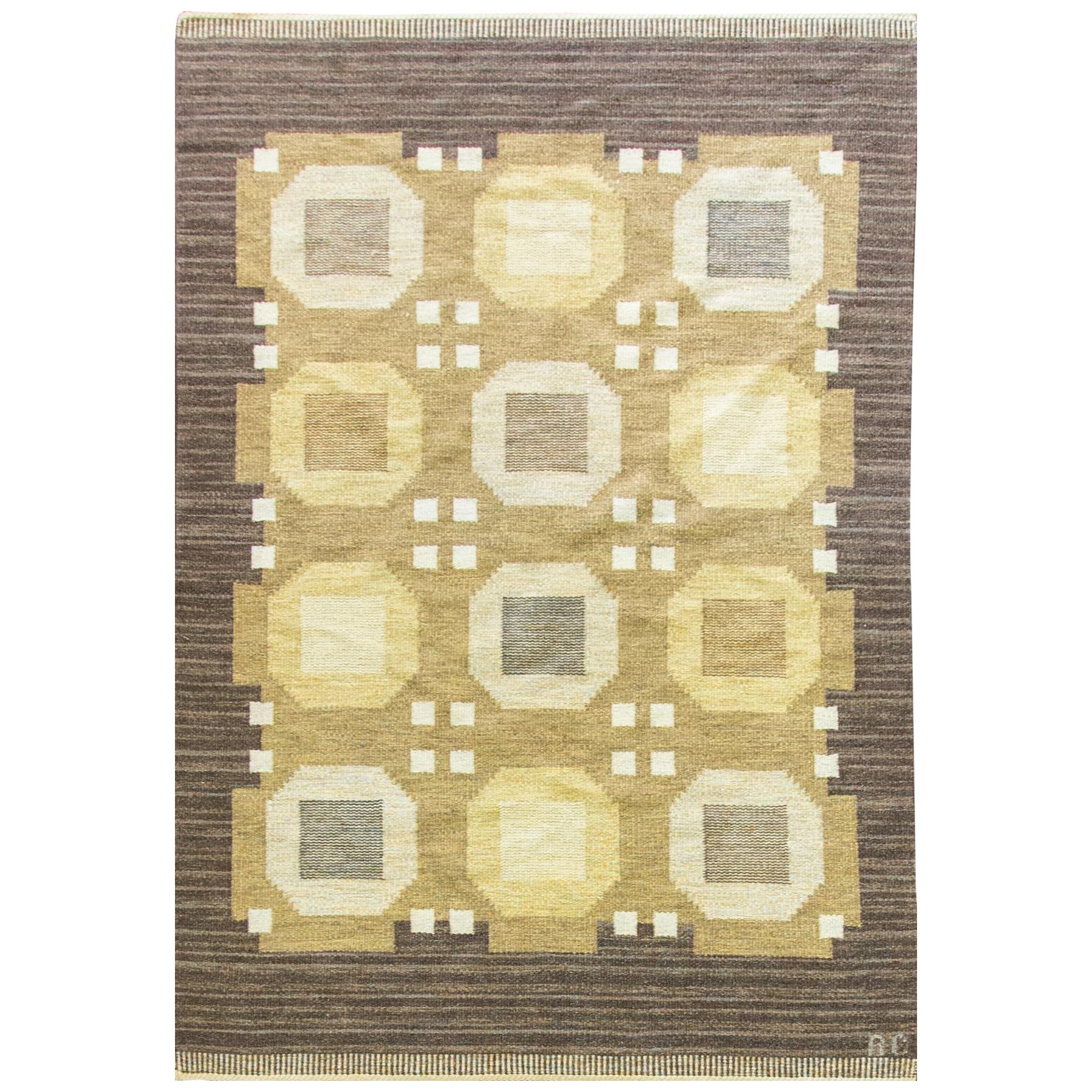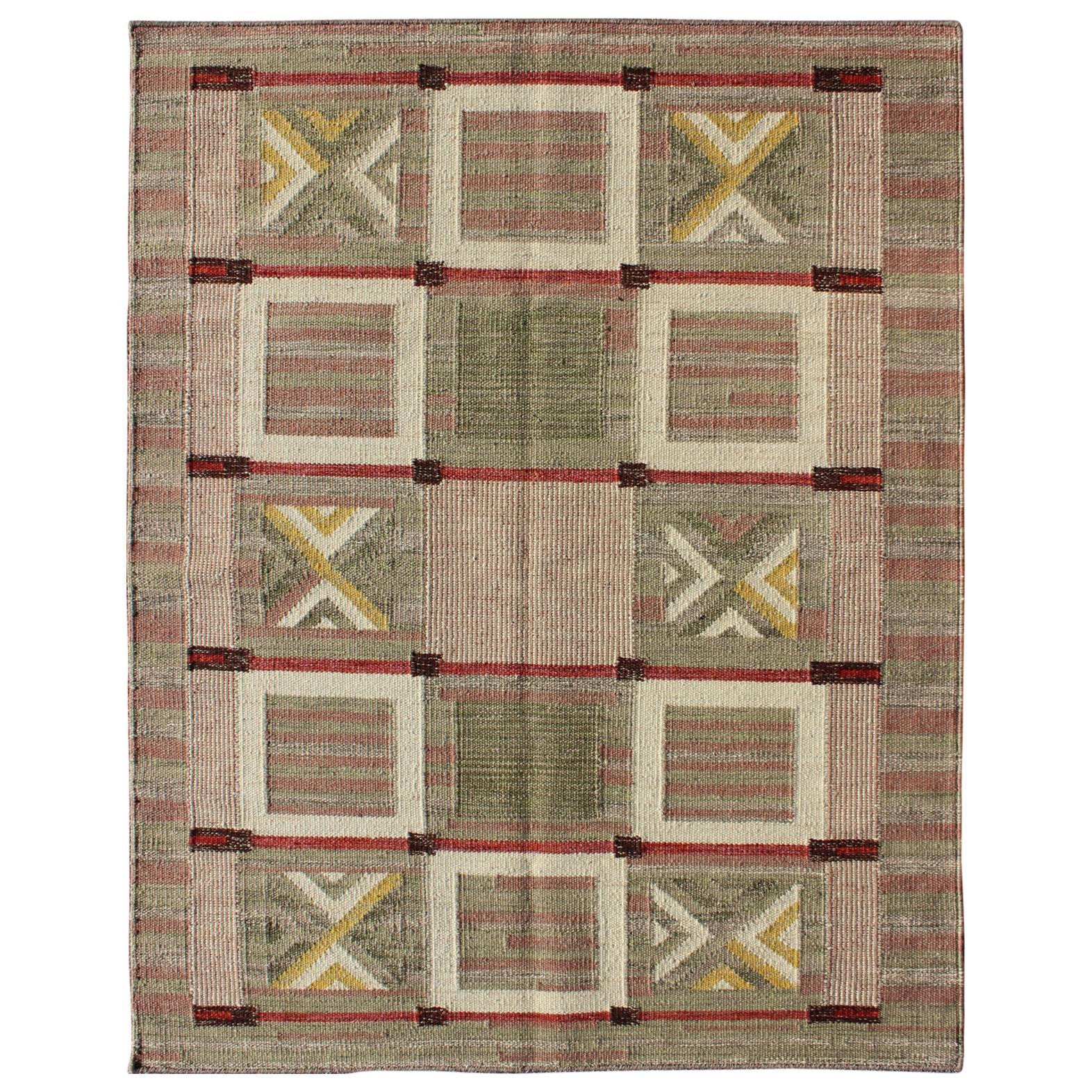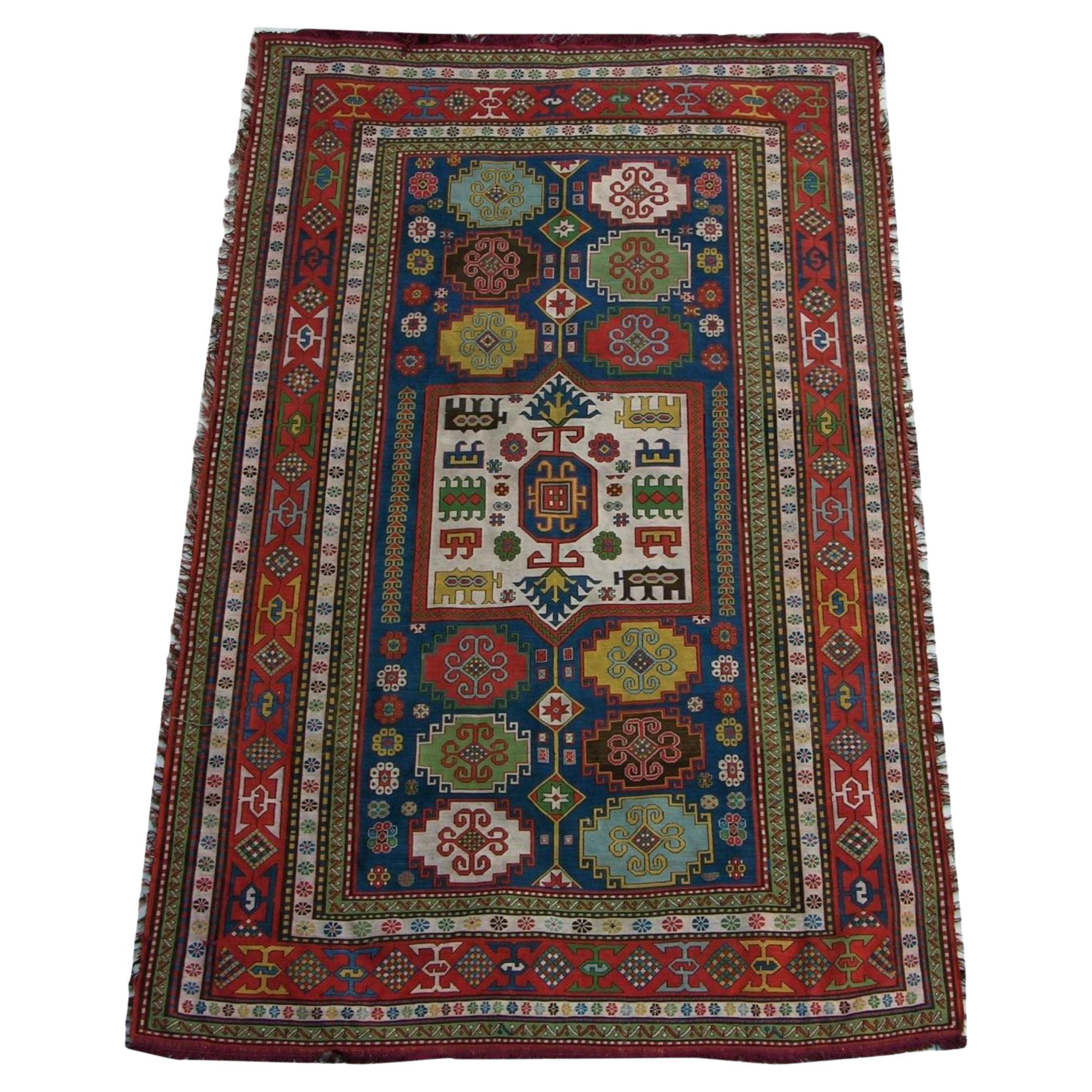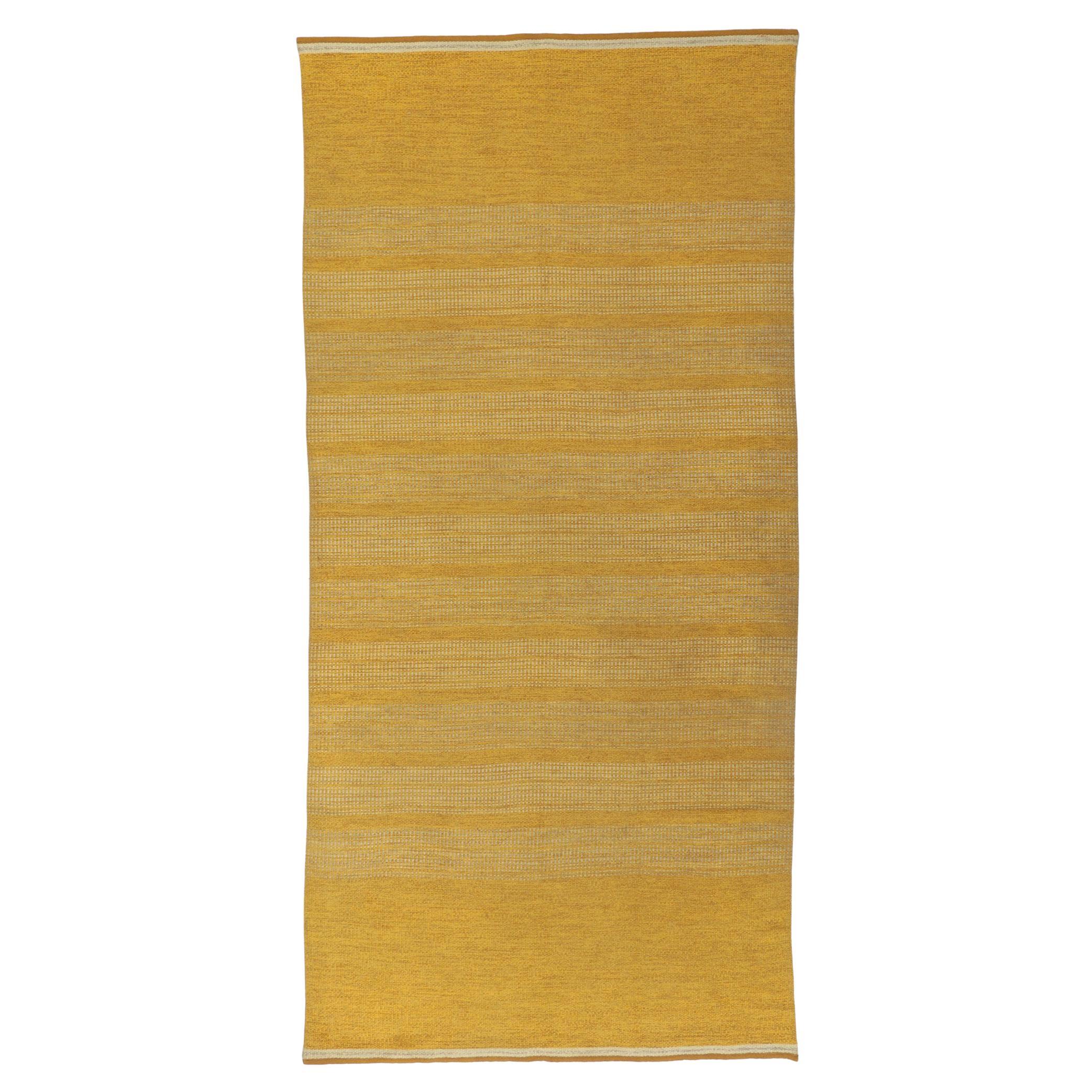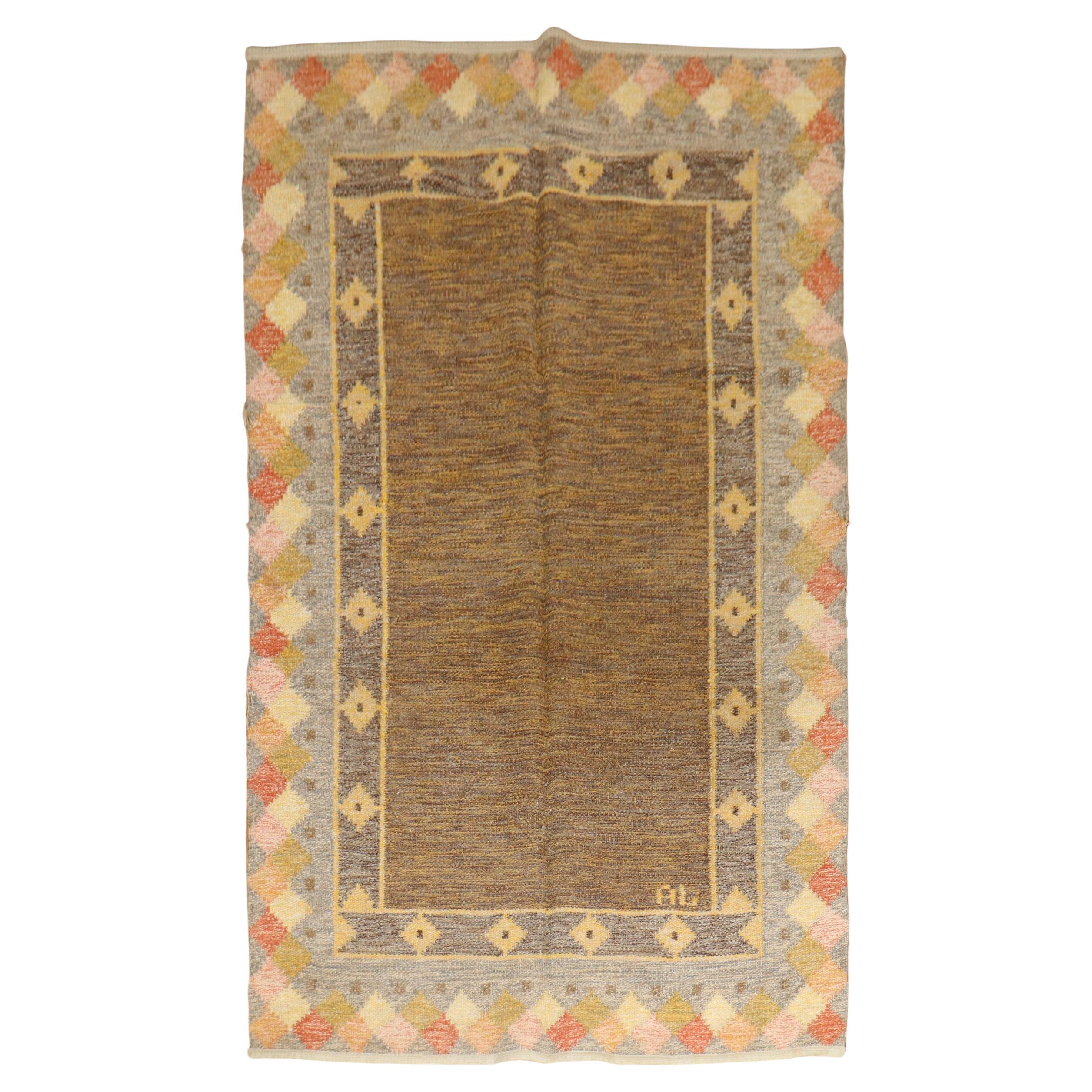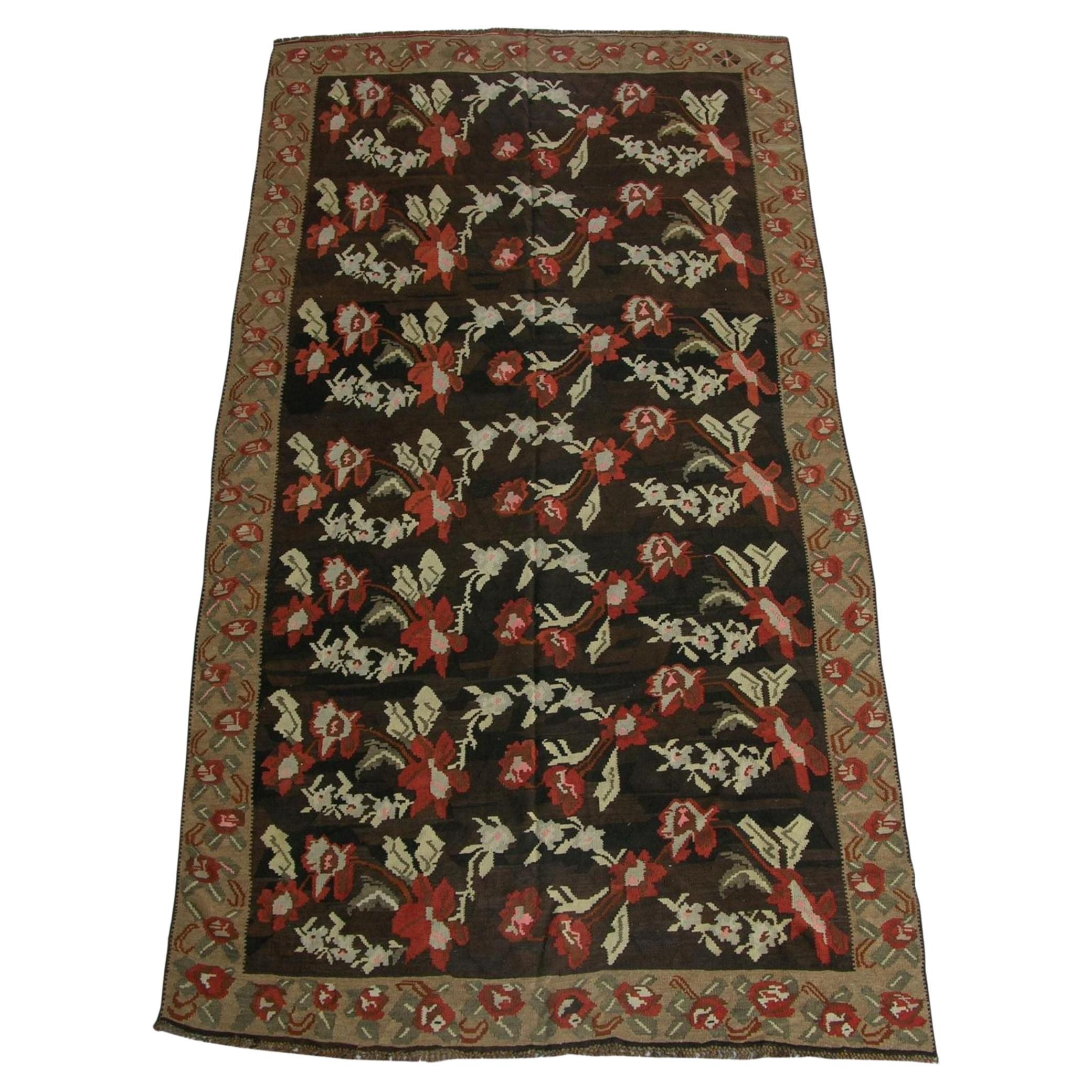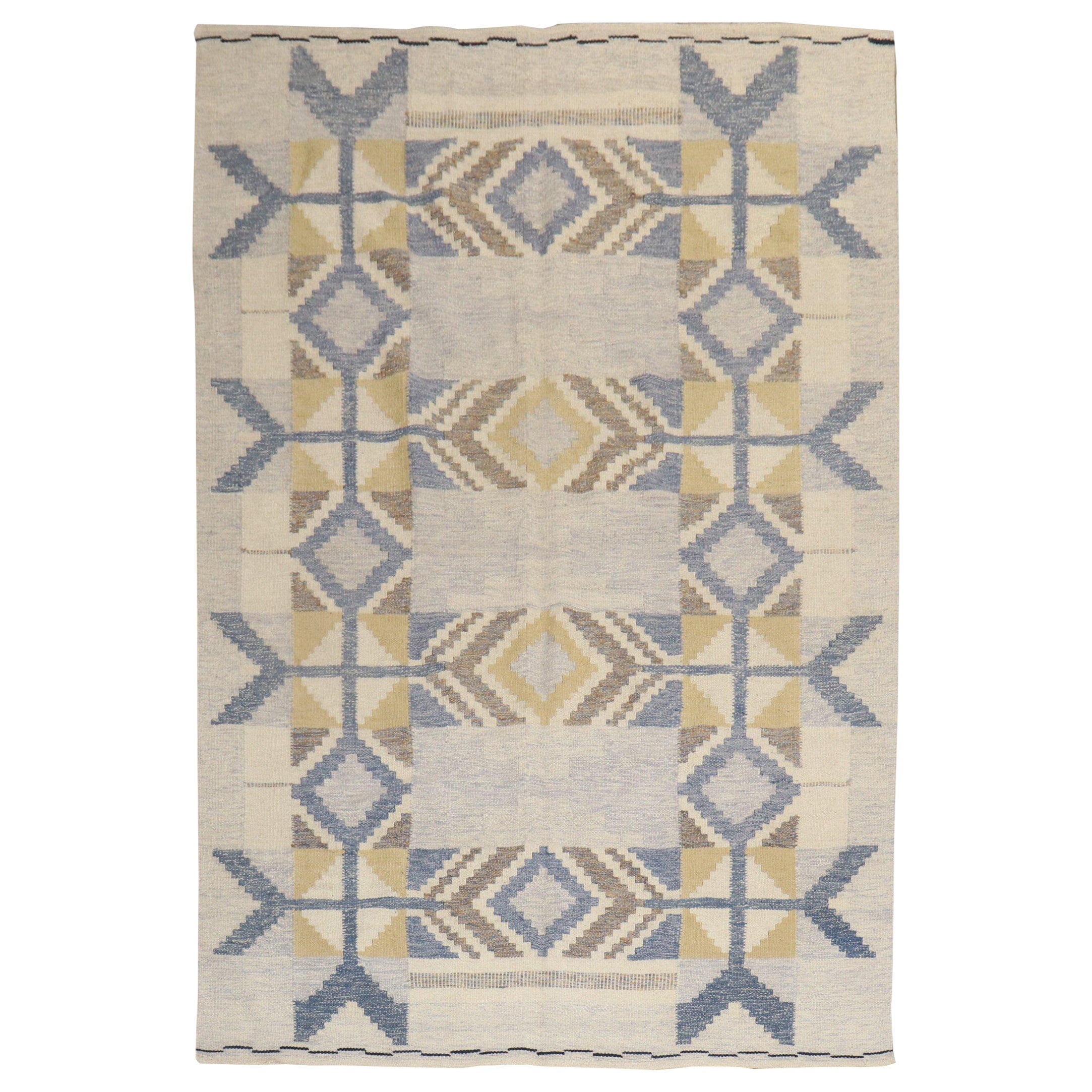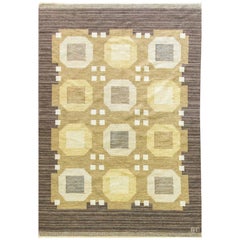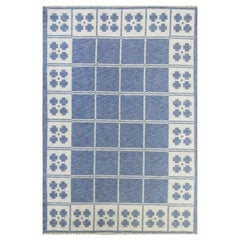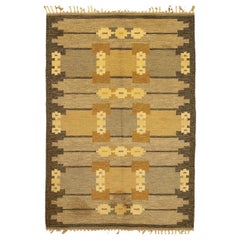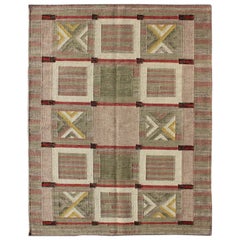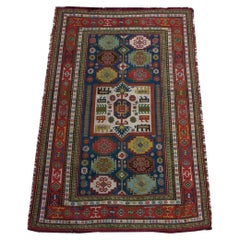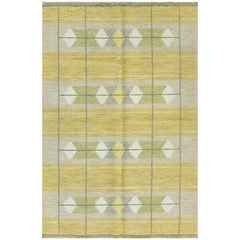
Swedish Kilim, Vintage, 4'4" x 6'9", Free Shipping
View Similar Items
Want more images or videos?
Request additional images or videos from the seller
1 of 11
Swedish Kilim, Vintage, 4'4" x 6'9", Free Shipping
About the Item
About the Seller
4.8
Vetted Seller
These experienced sellers undergo a comprehensive evaluation by our team of in-house experts.
Established in 1978
1stDibs seller since 2014
247 sales on 1stDibs
Typical response time: 3 hours
More From This SellerView All
- Swedish Röllakan Rug Signed IS Ingegerd Silow, Free ShippingBy Ingegerd SilowLocated in Evanston, ILA Scandinavian Modern Rollakan flat-woven carpet. Made in Sweden during the 1950- 1960s, midcentury period. Designer Ingegerd Silow, mark...Category
Mid-20th Century Swedish Kilim Russian and Scandinavian Rugs
MaterialsWool
- 20th Century Swedish Flat-Weave Carpet by Agda Osterberg, Free ShippingBy Agda ÖsterbergLocated in Evanston, IL20th century Swedish flat-weave carpet, initialed "RC" Rakel Callander. An incredibly talented Swedish rug weaver and designer, Rakel (Rachel) Callander is responsible for creating ...Category
Mid-20th Century Swedish Kilim Russian and Scandinavian Rugs
MaterialsWool
- Double Sided Swedish Kilim Rug, 5' x 7'5"Located in Evanston, ILDouble Sided vintage/antique handmade flat weave Swedish Kilim natural dyed wool Rug/carpet, 5' x 7'5", country of origin: Sweden / Scandinavia, circa mid-20th century. Geometric des...Category
Mid-20th Century Swedish Scandinavian Modern Russian and Scandinavian Rugs
MaterialsWool
- Antique Bessarabian Kilim, 5' x 7'. Free ShippingLocated in Evanston, ILBessarabian rugs in pile and tapestry technique originating in Russian provinces as well as Ukraine and Moldova Bulgaria and Romania during the late 19th and early 20th centuries. Pr...Category
Early 20th Century Romanian Kilim More Carpets
MaterialsWool
- Oushak Rug, Free ShippingLocated in Evanston, ILVintage Oushak vegetable-dyed wool rug with floral and geometric motif, central medallion, and several borders. Measures: 5'9" x 8'11".Category
Mid-20th Century Turkish Oushak Turkish Rugs
MaterialsWool
- Antique Khotan Carpet, Free ShippingLocated in Evanston, ILKhotan, an ancient Buddhist kingdom, was located on a branch of the famous Silk Road in Eastern Turkestan, in what is modern-day Xinjiang, China. Carpets from this region, though mad...Category
Early 20th Century Turkestan Khotan Central Asian Rugs
MaterialsWool
You May Also Like
- Swedish Kilim Vintage Signed "G S"Located in Ferrara, ITThis vintage Swedish Kilim rug is an extraordinary piece of craftsmanship. Woven circa 1920-1950, it features a beautiful all-over geometric design and the GS signature. The producti...Category
Early 20th Century Swedish Scandinavian Modern Russian and Scandinavian ...
MaterialsWool
- Customizable Modern Scandinavian/Swedish Geometric Design Rug 5' X 6'9''By Keivan Woven ArtsLocated in Atlanta, GAThis Scandinavian flat-weave patterned rug is inspired by the work of Swedish textile designers of the early to mid-20th century. Featuring a unique blend of historical and modern de...Category
21st Century and Contemporary Indian Scandinavian Modern Russian and Sca...
MaterialsWool
- Vintage Tribal Silk Soumak - 6'9'' X 4'3''Located in Los Angeles, USSoumak rugs (also spelled Sumak) – This construction technique produces a flat-weave rug that is thick, strong and exceptionally durable. Unlike kilims, Soumak rugs are not reversible because non-clipped yarns are left on the back. However, they are also stronger than kilims. Antique Soumak carpets are unique because the wefts are used to produce decorative patterns rather than as a structural element. Antique Soumak rugs are generally very finely woven and feature richly detailed motifs. Traditionally, these spectacular flat-weave carpets are decorated with ancient symbols, tiny birds and geometric animals. Many of these geometric patterns and tribal symbols are associated with the Shahsavan tribe. In the 17th century, these influential warriors served as the personal bodyguards to Shah Abbas according to historic legends. The Shahsavan, who used Soumak weaving techniques widely, inhabited modern-day Azerbaijan and parts of Northwest Persia near Ardabil. Because Soumak rugs were woven in various carpet producing regions, the designs they feature are exceptionally diverse. Although they are fairly rare compared to pile carpets and traditional kilims, antique Soumak rugs feature grand medallions, finely executed repeating patterns, Persian garden designs and tribal motifs that are surrounded by multiple sets of richly detailed borders. Antique Soumak rugs make outstanding floor coverings, but the technique was also used to construct bags, trappings, saddle covers, decorative bed spreads and functional household items. Like other regional handicrafts, antique Soumak rugs are highly decorative and diverse textile pieces that flatter modern furnishings and soften minimalist interiors very well. Soumak or Sumak is a type of brocading or flat-woven pile. Thicker than a kilim carpet, it is accomplished by looping the yarn horizontally around successive pairs of warps in between passes of over-under wefting. When compressed vertically with a weaver’s comb, the resultant texture looks like cabling rising slightly from the surface of the rug. Soumak is named for the village of Shemaka in the Caucasus where this technique was widely practiced, but it certainly was not invented there. Soumak has been practiced extensively across the antique rug producing world, from Central Asia to Iran, the Caucasus, and Turkey. Antique Soumak Weave Techniques: Soumak Weave – The art of fine rug weaving and making is ancient and complex. Over the centuries, a myriad of disparate cultures, from every corner of the globe, have developed methods of creating tight, long-lasting weaves, such as rugs, carpets, and kilims. As such, there is no singular, universal method for creating a fine weave; rather, there are several different, totally distinctive weaving techniques. These techniques and approaches have been developed over time and that are unique to the area, tribe and or people. One specific example of a type of weave that was developed and is still used to this day is the Soumak weave. The widespread adaptation of the Soumak weave by such a wide range of different rug-producing cultures is certainly a rather strong testament to the quality and “reproducibility” of the process — cornerstones of any long-lasted artistic technique. One of the most familiar types of antique weaving from the Caucasus region is the Soumak. These were produced in a wide array of designs, but generally they are typified by a crisp, precise drawing applied to highly abstract or stylized geometric patterns, using a rich and varied palette. In technical terms, Soumaks are flatwoven rugs. Their technique is related to that of kilims, but it is somewhat more complex, thicker in handle, and more durable as floor covering. As opposed to Kilim technique which consists of compacted weft facing simply running over and under the vertical wraps, Soumak weave runs the yarns around the warps in a serpentine pattern, over two, back one, over two back one, and so forth. The rows of this yarn facing or brocading are then separated by wefts like the rows of knots in pile carpets. The origin of this technique is hard to pinpoint, but it is attested literally from one end of the rug-producing world to the other. The term Soumak is apparently a corruption of the name Shemaka, a town in the Shirvan region of the Caucasus, where such rugs, it is often claimed, were made. However Soumaks were made in various areas of the Caucasus and the region north of Kuba seems to have been a major center of their production. Caucasian Soumaks have a very interesting design repertory, with a number of distinct types or groups. From the perspective of carpet history, the most interesting group is the one that utilizes field designs of large polygonal medallions, often in the shape of diamonds or stars. These tend to be modeled on early Turkish pile carpets, especially those of the so-called “small pattern Holbein” and “large pattern Holbein” types produced in Western Turkey during the fifteenth and sixteenth centuries. A key feature of the Holbein rugs is the use of small squares with horn-like hooked pairs as fillers in the indentations along the edge of the main medallions. Caucasian Soumaks of this type reproduce even these details with remarkable consistency and fidelity. The various smaller motifs used as space fillers seem to come from the common tribal repertory behind most Caucasian and Turkish rugs. The borders of Caucasian Soumaks tend to be made up of small geometric medallions or stylized rosettes, although they can be surprising, as on the example shown here which is adapted from kilim designs. A second major group of Caucasian Soumaks have allover field designs made up of smaller medallions arranged closely in staggered repetition. Some of these which have multi-pointed star-like configuration (the so-called Crivelli-Star) also come from the repertory of early Turkish rugs. But the oval medallions with undulating edges are floral palmettes of classical Persian derivation. Despite the varied origins of the design elements, the Soumaks of this group still convey considerable stylistic homogeneity or integrity. The borders of this second group are much the same as those of the first, although the example shown here has a highly unusual border that derives once again from early Turkish rugs. A third group of Caucasian Soumaks stems from more local traditions. Known as “Dragon Soumaks...Category
Vintage 1970s Tribal Russian and Scandinavian Rugs
MaterialsSilk
- Large Vintage Swedish Kilim RugLocated in Brooklyn, NYLarge Vintage Swedish Kilim rug by unknown designer. Brown border with a green, white and red geometric design against a large beige central area. Fringes have been shortened and wit...Category
Vintage 1950s Swedish Scandinavian Modern Russian and Scandinavian Rugs
MaterialsWool
- Vintage Scandinavian Swedish Kilim. Size: 4' 6" x 6' 8"Located in New York, NYVintage Kilim, Sweden, mid-20th century. Size: 4 ft 6 in x 6 ft 8 in (1.37 m x 2.03 m)Category
Mid-20th Century Swedish Kilim Russian and Scandinavian Rugs
MaterialsWool
- Vintage Swedish Kilim Rollakan RugLocated in Dallas, TX78505 Vintage Swedish Rollakan Rug, 05'11 x 12'05. This hand-woven wool vintage Swedish Kilim rug with Scandinavian Modern style features a striped pattern composed of both wide and ...Category
Mid-20th Century Swedish Scandinavian Modern Russian and Scandinavian Rugs
MaterialsWool

